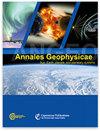Ionospheric density depletions around crustal fields at Mars and their connection to ion frictional heating
IF 1.9
4区 地球科学
Q3 ASTRONOMY & ASTROPHYSICS
引用次数: 0
Abstract
Abstract. Mars' ionosphere is formed through ionization of the neutral atmosphere by solar irradiance, charge exchange, and electron impact. Observations by the Mars Atmosphere and Volatile EvolutioN (MAVEN) spacecraft have shown a highly dynamic ionospheric layer at Mars impacted by loss processes including ion escape, transport, and electron recombination. The crustal fields at Mars can also significantly modulate the ionosphere. We use MAVEN data to perform a statistical analysis of density depletions of ionospheric species (O+, O2+, and electrons) around crustal fields. Events mostly occur when the crustal magnetic fields are radial, outward, and with a mild preference towards east in the planetocentric coordinates. We show that events near crustal fields are typically accompanied by an increase in suprathermal electrons within the depletion, either throughout the event or as a short-lived electron beam. However, no correlation between the changes in the bulk electron densities and suprathermal electron density variations is observed. Our analysis indicates that the temperature of the major ionospheric species, O2+, increases during most of the density depletion events, which could indicate that some ionospheric density depletions around crustal fields are a result of ion frictional heating.火星地壳场周围电离层密度损耗及其与离子摩擦加热的联系
摘要火星电离层是通过太阳辐照、电荷交换和电子撞击使中性大气电离而形成的。火星大气与挥发物进化(MAVEN)航天器的观测结果表明,火星电离层受离子逃逸、传输和电子重组等损耗过程的影响而高度动态。火星的地壳场也会对电离层产生重大影响。我们利用 MAVEN 数据对地壳磁场周围电离层物种(O+、O2+ 和电子)的密度损耗进行了统计分析。事件大多发生在地壳磁场呈径向、向外的情况下,并且在星心坐标中轻度偏向东方。我们的研究表明,在地壳磁场附近发生的事件通常伴随着损耗区内过热电子的增加,这种电子或贯穿整个事件,或形成短暂的电子束。然而,我们并没有观察到大量电子密度变化与超热电子密度变化之间的相关性。我们的分析表明,在大多数密度耗竭事件中,电离层主要物种 O2+ 的温度都在上升,这可能表明地壳场周围的一些电离层密度耗竭是离子摩擦加热的结果。
本文章由计算机程序翻译,如有差异,请以英文原文为准。
求助全文
约1分钟内获得全文
求助全文
来源期刊

Annales Geophysicae
地学-地球科学综合
CiteScore
4.30
自引率
0.00%
发文量
42
审稿时长
2 months
期刊介绍:
Annales Geophysicae (ANGEO) is a not-for-profit international multi- and inter-disciplinary scientific open-access journal in the field of solar–terrestrial and planetary sciences. ANGEO publishes original articles and short communications (letters) on research of the Sun–Earth system, including the science of space weather, solar–terrestrial plasma physics, the Earth''s ionosphere and atmosphere, the magnetosphere, and the study of planets and planetary systems, the interaction between the different spheres of a planet, and the interaction across the planetary system. Topics range from space weathering, planetary magnetic field, and planetary interior and surface dynamics to the formation and evolution of planetary systems.
 求助内容:
求助内容: 应助结果提醒方式:
应助结果提醒方式:


